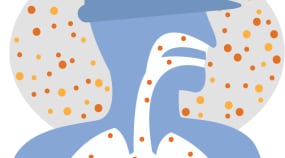What to know
- Silicosis is a lung disease that can affect people who work in mines and are exposed to airborne dust.
- Silicosis has no cure, so preventing it from occurring is essential.
- Personal monitoring and advances in detecting airborne silica can protect mine workers from getting silicosis.

Overview
Silicosis is a type of lung disease that miners are at risk of developing because of their exposure to airborne dust. This type of dust includes extra fine particles that people can inhale into their lung tissue.
Silicosis is a type of pneumoconiosis. Pneumoconioses (dusty lung) can cause impairment, disability, and premature death. The two main types of pneumoconioses that affect miners are silicosis and coal workers' pneumoconiosis.
During the extraction, transport, and processing of coal, ore, or stone in underground and surface mining operations, significant amounts of airborne respirable dust can be generated and expose workers. Controlling respirable (breathable) dust exposure can help prevent silicosis.
Silicosis can affect workers in many types of mines and quarries, including coal mines. Medical treatment cannot cure this disease, so preventing it is essential.
Tracking silicosis
Tracking of silicosis is not as regular or thorough as tracking of coal workers' pneumoconiosis. However, historic data from the 1990s attributes more than 23% of reported silicosis deaths to mining. On chest x-rays, r-type opacities are associated with silicosis lung pathology.
Over the last four decades, researchers have observed an increase in r-type opacities. This increase is primarily for miners in the Central Appalachian region. This change in disease profile for miners diagnosed with pneumoconiosis suggests that U.S. coal miners experience higher crystalline silica exposure than before.
Reducing risk of silicosis
Monitoring can be used to measure and quantify a miner’s exposure to toxic aerosols. Personal monitoring is the most common approach to assess worker exposure. Personal monitoring examines an integrated sample or multiple samples taken from the breathing zone of the worker during a period of time that can be extended to a full shift.
NIOSH research developed a personal dust monitor for miners to wear. This monitor provides an accurate measurement of the miner’s average respirable dust exposure immediately after their shift. The instrument also provides in-shift information on the miner’s ongoing dust exposure. Currently, this mine-site technique is most accurate for samples collected in coal mines. This information can help miners and mine operators identify a potential overexposure.
Traditionally, determining silica content requires sending a gravimetric filter to a laboratory for analysis. It can be days or weeks before mine operators receive the results. Real-time monitoring of respirable dust exposures enables mine operators to identify potential overexposures and implement interventions to prevent them.
